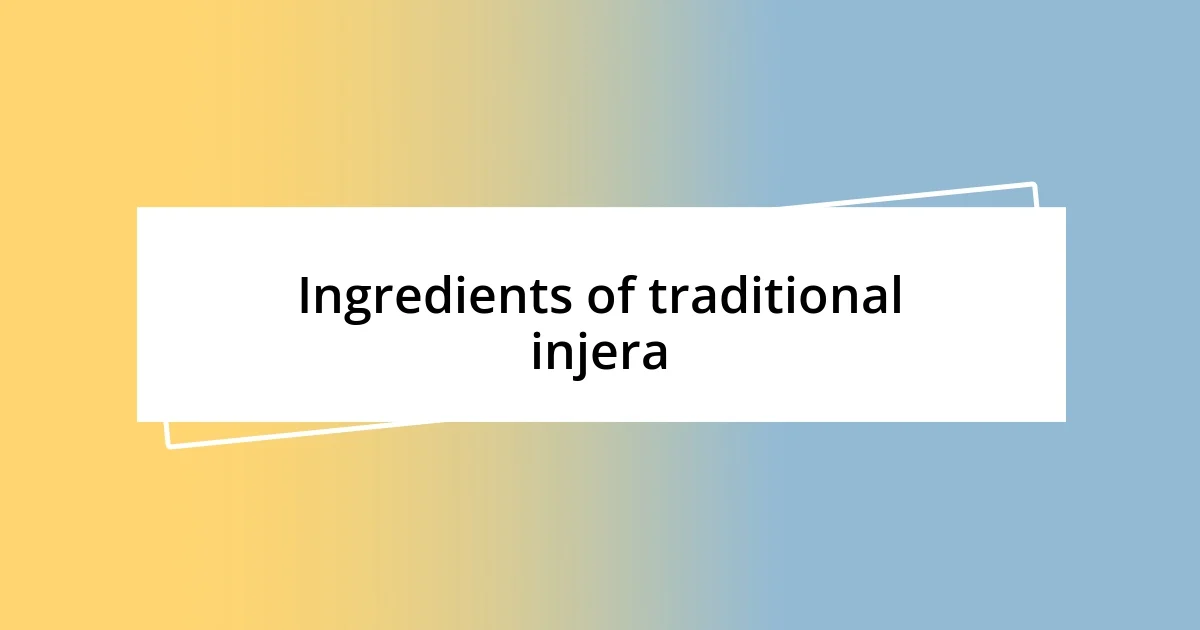Key takeaways:
- Injera is not only a staple food in Ethiopian cuisine but also serves as a cultural symbol of sharing and communal dining.
- The key ingredient in injera is teff flour, which, combined with fermentation, gives it a distinct flavor and texture essential to Ethiopian meals.
- Different types of wat, such as Doro Wat and Shiro Wat, highlight the diverse flavors of Ethiopian cuisine and enhance the dining experience when paired with injera.

Understanding Ethiopian injera and wat
Injera, a staple of Ethiopian cuisine, is more than just bread; it’s a cultural revelation. When I first tasted injera at a local Ethiopian restaurant, its unique spongy texture and slightly sour flavor made me feel like I was part of something special. Have you ever had a dish that connected you to a culture in such a profound way? Injera does that for many of us.
Wat, the rich stew typically served alongside injera, comes in various forms—some with meat, others vegetarian, and each bursting with a vibrant palette of spices. I remember trying doro wat, a chicken stew, for the first time and being overwhelmed by its warmth and depth of flavor. It’s fascinating how the spices tell a story of heritage, don’t you think? Each bite felt like an embrace from the Ethiopian culinary tradition.
What’s remarkable is how injera serves not just as food but as a utensil—it’s a symbol of sharing and communal dining. I can still picture the joy in my friends’ eyes as we tore off pieces of injera to scoop up our wat, creating a shared experience that extended beyond the plate. Isn’t it amazing how food can weave connections between people? This communal aspect brings intimacy and warmth to meals, making every gathering memorable.

Ingredients of traditional injera
In traditional Ethiopian cooking, the heart of injera lies in its simple yet essential ingredients. The primary component is teff flour, a gluten-free grain native to Ethiopia, which lends injera its distinct taste and texture. I vividly remember the first time I learned about teff; the thought of using such a nutritious grain made my appreciation for this dish deepen even more. Have you ever thought about how the choice of grain can influence the overall flavor profile of a dish? Teff’s nutty undertones certainly make injera unique.
Adding to the magic is the fermentation process, where water is mixed with the teff flour, allowing natural yeast to develop. This step is crucial as it introduces that slightly sour flavor that sets injera apart. Once, while visiting an Ethiopian friend’s home, I saw her preparing the batter and felt a wave of nostalgia. It’s incredible how a simple act like fermentation can not only enhance flavors but also connect generations of Ethiopian families through shared culinary practices.
To perfect the injera, the batter is poured onto a hot, round griddle called a mitad. This cooking method creates injera’s signature spongy texture with tiny holes that help soak up the accompanying wat. I recall watching the injera cook, the delight in my heart as the edges began to lift, begging to be torn apart and savored with rich stews. It became clear that each ingredient plays a pivotal role, crafting a harmonious balance that elevates a meal from mundane to extraordinary.
| Ingredient | Purpose |
|---|---|
| Teff Flour | Main ingredient; provides flavor and nutrition |
| Water | Necessary for batter formation and fermentation |
| Yeast | Facilitates fermentation for sourness and texture |
| Mitad (griddle) | Used for cooking injera |

Discovering different types of wat
Exploring the world of wat is an adventure filled with flavor and history. Each type of wat has its own unique character, showcasing the spices and ingredients that define Ethiopian cuisine. I’ll never forget the first time I tried shiro wat, a smooth chickpea stew infused with aromatic berbere spice. The experience was eye-opening—one spoonful and I was transported into the warmth of Ethiopian hospitality, where every bite tells a story.
Here are some captivating types of wat to discover:
- Doro Wat: A spicy chicken stew traditionally prepared for holidays and celebrations, known for its deep flavor from berbere spice and slow-cooked chicken.
- Shiro Wat: A rich and creamy chickpea stew, perfect for vegetarians, made with ground chickpeas and seasoned with a mix of spices.
- Kitfo Wat: Raw minced beef seasoned with mitmita and served warm; for those bold enough, this dish is a true test of flavors.
- Gomen Wat: A delightful stewed collard greens dish, often cooked with onions and spices, showcasing the beauty of simple ingredients.
- Misir Wat: A flavorful lentil stew that embodies the essence of vegetarian Ethiopian dishes, cooked with spices that warm the soul.
With discovering each wat, I find myself appreciating the intricate balance of flavors that comes from hours of simmering and the lives touched by each recipe passed down through generations. Each dish creates not just a meal, but a shared cultural experience that lingers in my heart.

Pairing injera with various wats
Pairing injera with different wats transforms a meal into a vibrant culinary experience. For instance, when I savored Doro Wat, the spicy chicken stew, I found that the soft, sponge-like injera soaked up the rich sauce beautifully, each bite bursting with flavors. How does it feel to have a dish that’s not just food but an emotion, a celebration on your plate?
Shiro Wat, with its creamy texture, pairs seamlessly with injera, creating a comforting harmony. I still remember one rainy evening when I shared a plate with friends, laughter filling the air as we tore the injera, dipping it into the shiro. The warmth of the stew, combined with the tangy injera, felt like a hug for the soul. Don’t you think certain meals have a way of bringing us closer together?
Then there’s Misir Wat, a lentil stew that carries so much heart. Enjoying it with injera feels like a connection to Ethiopia’s roots and rich culture. Each bite is not just a taste; it’s a story of resilience and tradition. I often wonder, how can something so simple evoke such depth of emotion and connection among people?

Tips for enjoying Ethiopian meals
Ethiopian meals are best enjoyed with your hands, creating a sensory experience that’s truly unique. I recall my first time ripping off a piece of injera and using it to scoop up some Doro Wat. There’s something incredibly fulfilling about connecting with your food like that; it’s almost primal. Have you ever felt that thrill of participating in your meal, rather than just consuming it?
Serving meals on a communal platter is essential, as it encourages connection and sharing. One of my fondest memories is gathering around a large plate filled with various wats, everyone reaching in together. It fosters a sense of belonging and warmth. I often ask myself, isn’t it interesting how food can bridge gaps between people, transcending language and culture?
Lastly, don’t forget the importance of enjoying your meal slowly. Savoring each bite can transform the dining experience. I still cherish evenings spent lingering over a flavorful Misir Wat, letting each spoonful ignite my taste buds with its rich spices. It’s a reminder that enjoyment doesn’t just come from the flavors but from the moments spent with loved ones around the table. What’s better than finding joy in both the meal and the company?














